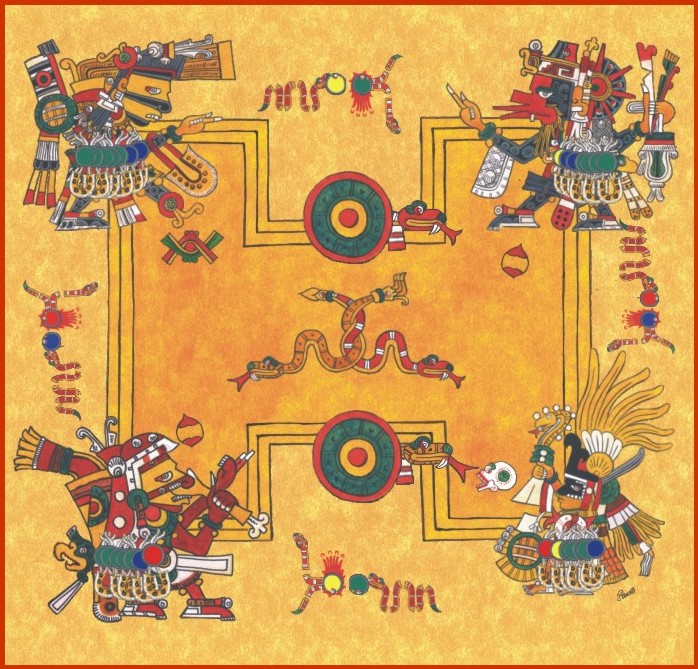Prehispanic Supersymmetry


The design of the poster of ELAF 2004 is inspired by the concept of supersymmetry as used in nuclear and particle physics and the `Juego de Pelota', the ritual game of prehispanic cultures.
Ometéotl, the dual God (from the roots ome = two and téotl = God) subdivides into Omecíhuatl (cihuatl = woman) y Ometecutli (tecutli = man), giving rise to the dual divine couple. This duality manifests itself as the creation principle that characterizes the nahau philosophy. The Omeyocan, the place of the duality, is later a witness to the birth of the four gods: Quetzalcóatl, Huitzilopochtli, Tezcatlipoca y Camaxtle. They govern the four cardinal points and have certain colors and qualities associated with them.
The principal idea of the drawing consists of the representation of the ball court of a ritual game (`Juego de Pelota') of prehispanic Mexico, in which the four children of the divine couple take place. Each one of the gods represents a nucleus, on the top left Tezcatlipoca: the even-even nucleus 194Pt, top right Quetzalcóatl: the odd-even nucleus 195Pt, bottom left Camaxtle: the even-odd nucleus 195Au, and finally Huitzilopochtli: the odd-odd nucleus 196Au. The association between the gods and the nuclei is made via the number and the color of the balls that each one of the players carry. The green and blue balls correspond to the neutron and proton bosons, whereas the yellow and red ones correspond to a neutron and a proton fermion, respectively. The one-nucleon transfer operators that induce the supersymmetric transformation between different nuclei, are represented by red coral snakes (`coralillos'). The snakes that create a particle carry a ball in their mouth whose color indicates the type of particle. On the other hand, the snakes that annihilate a particle carry the corresponding ball soaking with blood that seems to split their body. Both types of snakes we see in segmented form, in representation of the quantization of energy. In the world of the ancient Mexico both living and dead creatures form a coherent unity and harmonize in the same plane of importance. This is reflected in the eyes that are included in all components of a graphical representation. For this reason, the balls associated with the creation and annihilation of particles have eyes.
The central figure in the ball court consists of two intertwined snakes, a coral snake and a rattle snake. They represent another aspect of supersymmetry as it is used in particle physics, in which each particle has its supersymmetric counterpart. The reason that this is symbolized by snakes is their property to change skins. Thus, a change of skin of two apparently different snakes suggests the transformation between bosons and fermions. The same two snakes make their appearance on the circular stone rings, the `score board' of the aztec ball game. In the ball court one finds, at the feet of Tezcatlipoca the symbol Ollin, movement, which represents the uncertainty principle. Similarly, we see a heart in the upper right and the lower left part. The hearts have two meanings. On the one hand they characterize the ritual aspect of the ancient game `Juego de Pelota' and, on the other hand, they represent the `road with a heart', which science could follow. Finally, next to Huitzilopochtli there is a skull to remind us of the fleeting nature of our existence.
February 2004, Renato Lemus Casillas (renato@nuclecu.unam.mx)